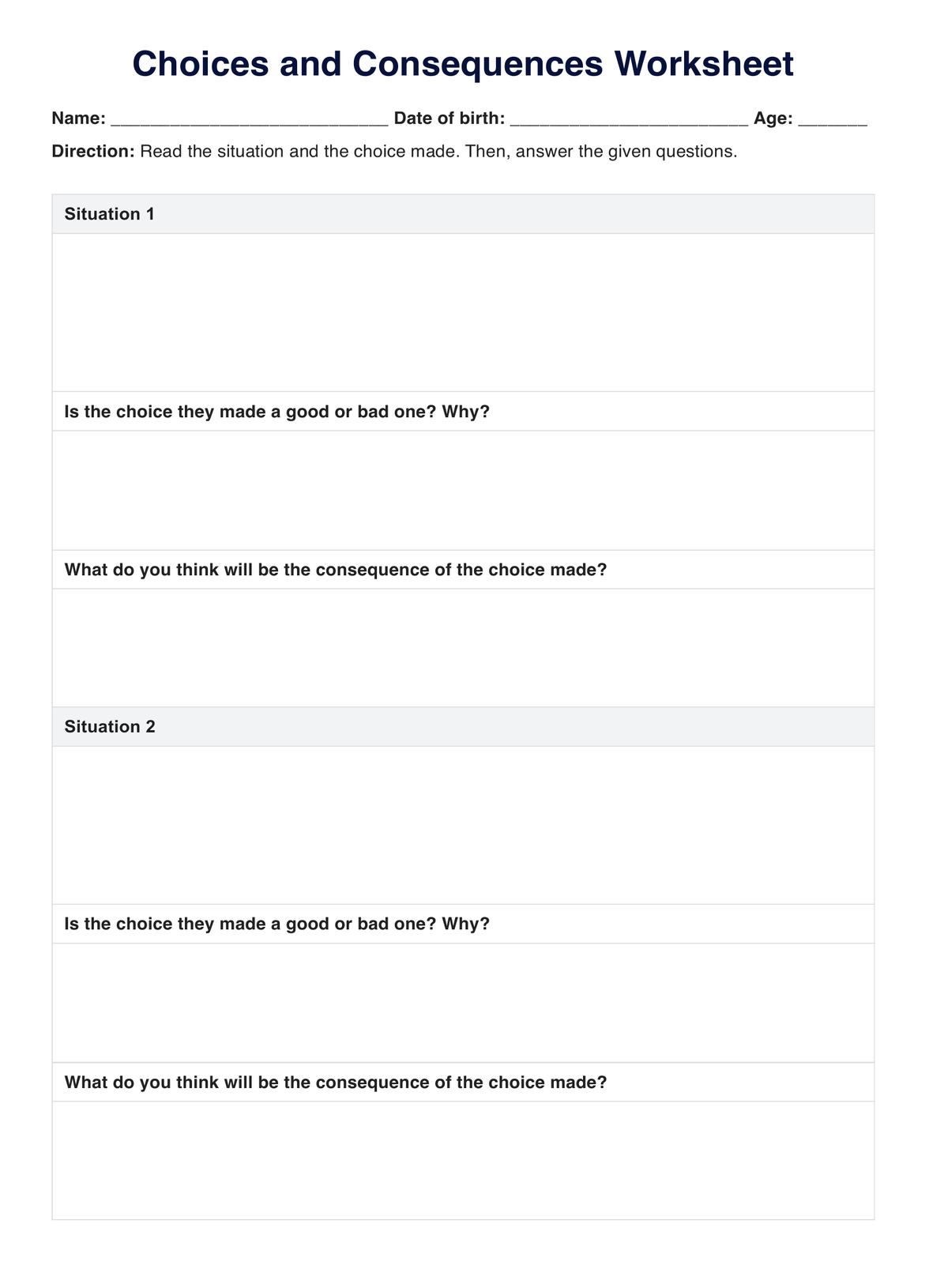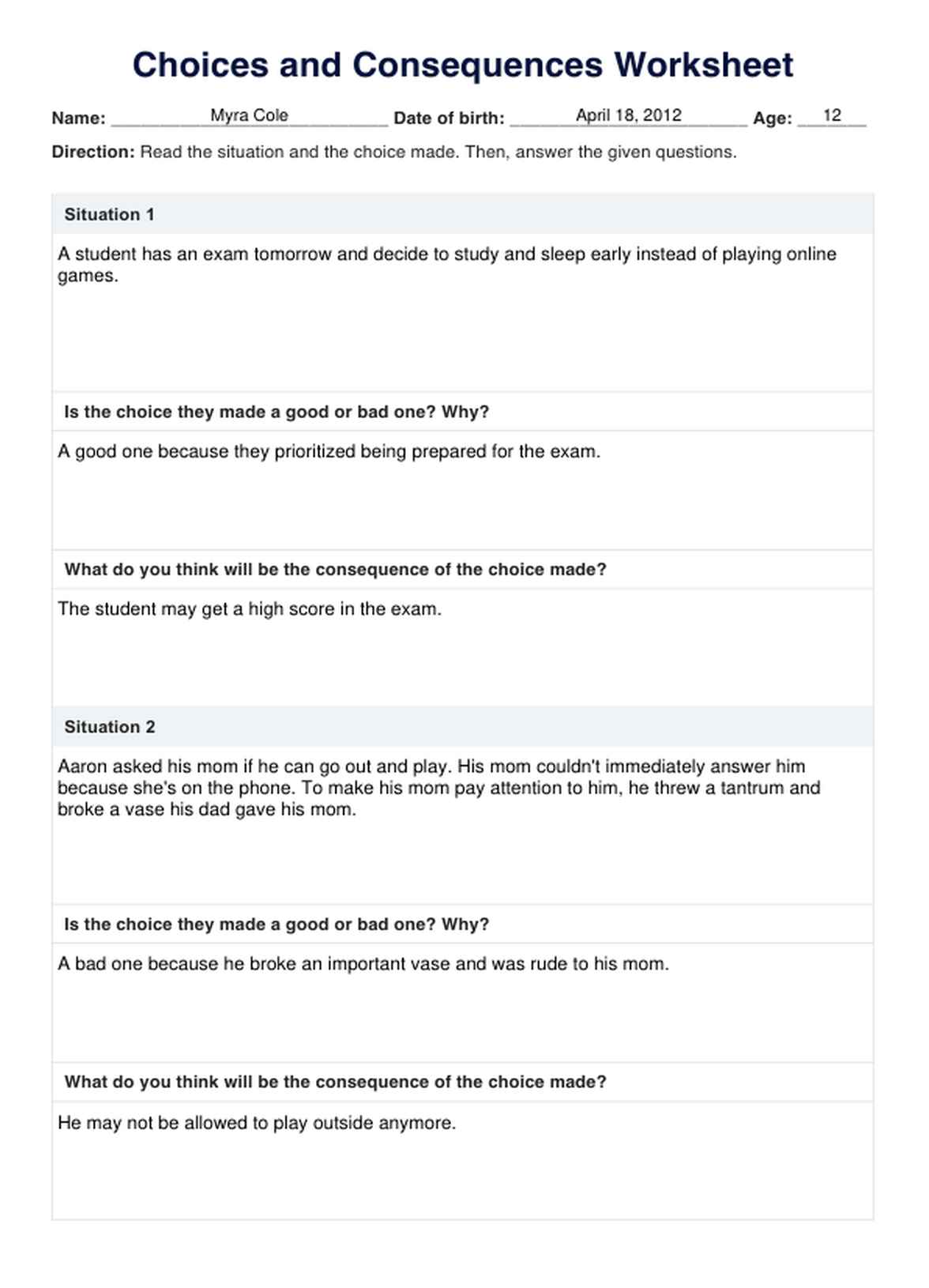Choices and Consequences Worksheets
Use our Choices and Consequences Worksheets to teach children and young clients about responsible decision-making.


Relationship between choices and consequences
The relationship between choices and consequences is a fundamental concept in life. Choices are the decisions one makes, while consequences result from one's decision. Every day, one makes choices, and each has consequences whether they realize it or not.
Some key points of this relationship are:
- Everyone has a choice, and even if one feels like they don't have one, it isn't the same as not having one. One must learn to see their choices.
- Everyone has a role in the decision-making process, even if it feels like the decision has been made for them. Similar to the key point above, one must realize that it's important to recognize their decisions.
- Everyone must learn to be aware of the possible consequences of their choices and accept them, whether they have negative or positive outcomes.
Despite these points, it's also crucial to remember that not all choices have apparent or discernible consequences. However, the bigger the difference between the choices, the more there is at stake. Therefore, no matter how small or large, it's important that one has to make choices with regard for the logical consequences.
Choices and Consequences Worksheets Template
Choices and Consequences Worksheets Example
What are Choices and Consequences Worksheets?
Choices and Consequences Worksheets are educational tools healthcare professionals or counselors use to help students understand the relationship between their decisions and their potential consequences. They are often used in a social-emotional learning environment to help students learn about responsible decision-making and to hone their critical thinking skills.
Oftentimes, these Choices and Consequences Worksheets differ in content. However, all creators of the worksheet and the facilitator or educator who use them during sessions have the same goal: teaching children how to think critically about their actions and understand the potential impact of their choices.
Examples of Choices and Consequences Worksheets
As mentioned above, there are multiple types of Choices and Consequences Worksheets. Here are a few you may find useful.
What are the consequences?
The 'What are the consequences?' worksheet asks students to read the situations provided and the hypothetical persona's choices. Afterward, they are asked to answer several questions, such as: 'Is the choice they made a good or bad one? Why?" and "What do you think will be the consequence of the choice made?"
Choices and consequences matching activity
The 'Choices and Consequences Matching Activity' worksheet is designed to teach choices and consequences to a small group of elementary students or learners. For this worksheet, the students have puzzle pieces of different choices and consequences. The students must aim to put together what they think is the most likely consequence of a particular choice.
I have, who has
The 'I Have, Who Has' worksheet is designed for groups, similar to the one above, and contains multiple cards that the classroom teachers or school counselors must cut out and distribute to their students or clients. When each student has both an 'I Have' and 'Who Has' card, they will be asked to read the 'Who Has?' from their cards, and the rest of the group will see if they have a matching 'I Have' card. The activity will continue until everyone gets a chance to read their 'Who Has?' card and receives an 'I Have' card in return.
How to use our Choices and Consequences Worksheet template
Utilizing a Choices and Consequences Worksheet can be an invaluable tool in fostering critical thinking skills and promoting thoughtful decision-making among students. Here's a step-by-step guide on how to effectively utilize our Choices and Consequences Worksheet:
Step one: Introduce the worksheet
Begin by downloading the worksheet within this guide and introducing it to the students by outlining it's purpose and significance in developing their decision-making abilities and helping them anticipate the potential outcomes of their actions before making a decision.
Step two: Fill out the worksheet
Have your students or clients fill out the worksheet, asking them to read the situations you provided and reflect on their answers to the questions provided. If they are stuck, you may provide them with prompts and questions to aid with reflection.
Step three: Facilitate discussion
After your students or clients complete the worksheet individually, encourage them to engage in a group discussion to share their predictions and evaluations of the scenario. This exchange allows for peer learning and allows students to consider differing perspectives and insights. During this time, you may provide feedback and guidance, reinforcing positive contributions and offering constructive criticism where necessary.
Step four: Encourage application
As a final task, encourage them to apply the skills and concepts they learned through the worksheet to real-life situations. Challenge them to actively consider the potential consequences of their decisions and empower them to make informed choices in their daily lives.
Benefits of using this worksheet
Integrating the Choices and Consequences Worksheet into your lesson or session has multiple benefits. Some of these are:
- Catalyzes critical thinking: The worksheet prompts students to analyze real-life scenarios and discern the causal relationship between actions and their outcomes. As a result, they enhance their analytical skills and understand the complexities of decision-making.
- Instills a sense of responsibility: As the children learn about the repercussions of their choices, they will also understand accountability and be more empowered to take ownership of their decisions and their subsequent effects.
- Facilitates introspection and reflection: Since the worksheet allows them to contemplate their decisions and consequences, they also cultivate a sense of self-awareness and empathy, thus nurturing their vital social-emotional skills.
Commonly asked questions
There are multiple ways to teach choices and consequences, such as answering worksheets, group discussions, storytelling, and role-playing.
It can take around 30 minutes to fill out the Choices and Consequences worksheet. However, the duration may change depending on the children's critical thinking capabilities and whether or not they will receive assistance.
Aside from school counselors and classroom teachers, healthcare professionals who aid a child's emotional and mental development may find the worksheet helpful. Parents may also use the worksheet only under the recommendation or guidance of their child's counselor.

























-template.jpg)













































































